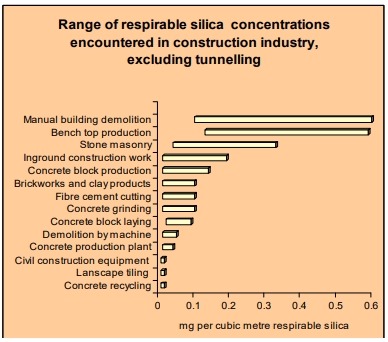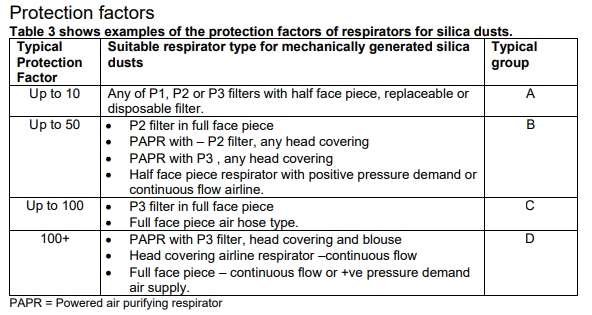Respirator Fit Testing in the Construction Industy
Date Posted:7 August 2018
The requirement to wear a properly fitted respirator extends beyond the asbestos removal industry and actually includes anyone working where there is a danger of airborne contaminants being inhaled. A fit-test is used to ensure the respirator provides the level of protection required to prevent exposure to contaminants including dusts, mists, fumes, gases and vapours.
Not all respirators fit all faces - a fit test is designed to measure a respirators effectiveness whilst the user performs a series of moving, breathing and talking exercises designed to simulate actual use in the workplace. A poor fitting respirator can allow the contaminants to enter the mask and compromise the safety of the wearer. Facial hair will in most instances cause the wearer to fail a fit-test.
When is a Fit Test Required?
- Whenever a respirator/mask is first issued to the wearer; then
- Annually for all tight fitting respirators
- Whenever a medical provider, the employer, or the employee has reason to believe the respirator no longer fits due to facial changes, weight changes, or scars.
- When the employee experiences a medical condition that impacts or could impact safe respirator use
Which respirators and dust masks need to be tested?
The following can be tested for facial fit with each offering an increased level of comfort and protection -
- P2 Disposable masks (single-use only).
Respirator filters are graded in terms of their performance in removing particles from air to be inhaled. P1 filters have the lowest performance, and P3 filters the highest - Half-face respirators (replaceable filters, increased comfort and fit)
- Full-face masks (a P3 Filter can remove up to 99.95% of airborne particles)
- Full-face Self-Contained Breathing Apparatus (SCBA); and
- Full-face Powered Air Purifying Respirator (PAPR) (both offer professional quality)
Types of Fit Testing
There are two types of fit testing available - Quantitive and Qualitive. A Quantitative test uses a portable respirator to scientifically measure the amount of contaminants in the air and entering the test respirator. Passing a Quantitative fit test proves that the respirator is sized correctly and the person is competent in donning the respirator. Upon passing a quantitive fit test, the person is issued with a fit test report indicating the overall fit factor.
A qualitative fit test is 'subjective' and relies on the employee's response to a test agent. Qualitative fit testing is a pass/fail test method that uses your sense of taste or smell, or your reaction to an irritant in order to detect leakage into the respirator facepiece. Qualitative fit testing does not measure the actual amount of leakage and because of this, the quantitive fit test is preferred in many industries.
Best Practice - Quantitive Fit Testing
The use of respirators in the construction industry
The dangers of working with asbestos are well documented (asbestosis, a lung disease resulting from the inhalation of asbestos particles) - The asbestos removal industry is tightly regulated to protect workers (and the environment) from the dangerous effects of this product. The production of airborne silica dust in the construction industry presents a similar danger to worker health.
Construction Dust (Respirable Crystalline Silica (RCS)

Quartz is common in many building materials and can be found in varying concentrations. For example, Sand and Sandstone products (96-100%), Calcium-silicate Bricks (50-55%), Aggregate in Concrete (30%), Clay Bricks (15-27%) Fibre Cement Sheets (10-30%).
Cutting, drilling, sawing and even demolition of products containing quartz can create dust and release fine particles, which if inhaled, can result in long-term silicosis (cancer of the lungs). Safe-work practices that reduce or eliminate dust are required. Respiratory protection does not prevent or control RCS from becoming airborne and should not be used as the primary means of control, but rather in combination with othe controls.
Where dust cannot be removed by controls such as dust extraction or water suppression, for example, a respirator can be used to provide additional protection.
The Required Minimum Protection Factor (RMPF) can be calculated as a concentration of RCS (mg /m3 volume), below. The higher the concentration, the more respiratory protection required. Comparing the required minimum protection factor against the fit-factor (calculated by completing a qualitive fit-test), the wearer can be sure that sufficient protection has been obtained to exceed the workplace exposure standard.


Resources
Further information about the selection, use and maintenance of respirators can be found in Australian Standard AS/NZ 1715:2009
WHSQ guidance:
- Fit-testing requirements for tight-fitting respirators (PDF, 1189.98 KB)
- Work-related respiratory diseases
- Health monitoring
- Silica – Technical guide to managing exposure in the workplace (PDF, 647.66 KB)
- Silica—Identifying and managing crystalline silica dust exposure (PDF, 182.15 KB)
- Silica and the lung (PDF, 229.8 KB)
WHSQ reports:
- Occupational dust and silica conditions in some Queensland construction and related industries (PDF, 234.58 KB)
- Tunnelling road header and related operations: dust conditions and their control (PDF, 152.09 KB)
- Tunnelling road header operations: dust conditions and their control (summary report) (PDF, 104.1 KB)
Safe Work Australia guidance:
- Crystalline silica - Hazardous Chemicals Requiring Health Monitoring
- Health Monitoring for Exposure to Hazardous Chemicals - Guide for workers
- Health Monitoring for Exposure to Hazardous Chemicals - Guide for persons conducting a business or undertaking
